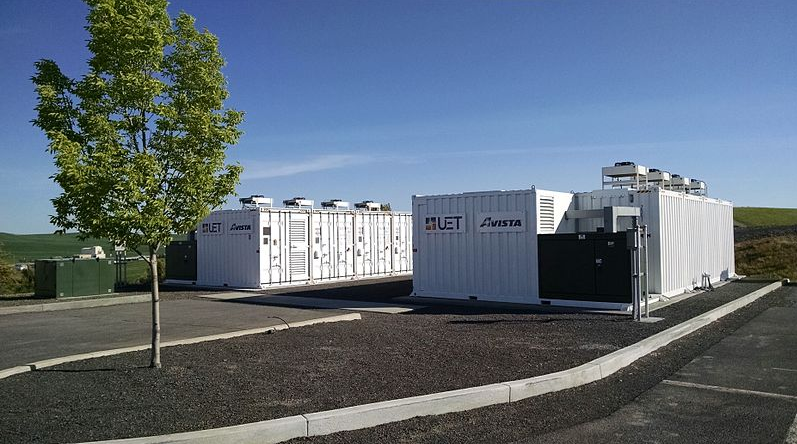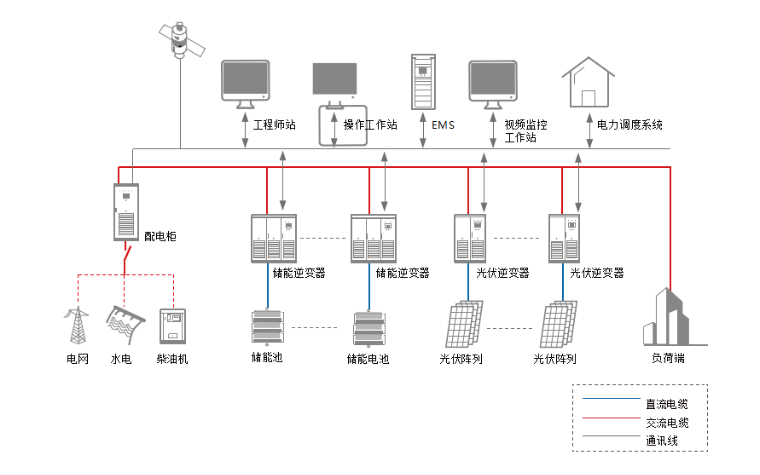What is energy storage? It is an important part of power production in the six links of "extraction - generation - transmission - distribution - use - storage". The energy storage systems can realize energy transfer and promote the application of new energy; they can establish micro-grids and provide power for the areas without power; they can adjust peak frequency and improve the stability of power system operation. The energy storage system is of great strategic significance to the construction of a smart grid.
The ways of electric energy storage include battery-type energy storage, inductor-type energy storage, capacitor-type energy storage, and other types of energy storage.
Battery Energy Storage System, referred to as BESS is a use of lithium batteries/lead batteries as an energy storage carrier, a certain period to store power and a certain period to supply power system and provide power with a smooth transition, peak shaving to fill in the valley, frequency and voltage regulation and other functions.
Inductor-type energy storage: the use of itself is an energy storage original, its stored electrical energy and its inductance and flow through its current is proportional to the square: E = L * I * I / 2. Because the inductor is at room temperature resistance, resistance to consume energy, a lot of energy storage technology uses a superconductor. Inductive energy storage is still immature and has fewer applications;
Capacitor-type energy storage: itself is also a kind of energy storage original, its stored power and its own capacitance and terminal voltage are proportional to the square: E = C*U*U/2. Capacitor energy storage is easy to maintain and does not need a superconductor. Supercapacitors are produced using capacitor-type energy storage to provide instantaneous high power and are suitable for applications such as lasers and flash lamps.
In addition, there are other types of energy storage: for example, mechanical energy storage.
Containing energy storage, photovoltaic, hydroelectricity, etc., the energy storage system is the core component of the microgrid, often used in conjunction with photovoltaic and wind power.
As battery energy storage has the advantages of relatively mature technology, large capacity, safety and reliability, low noise, strong environmental adaptability, ease of installation, etc., the energy storage system is commonly used to store electricity, the current energy storage system is mainly composed of the energy storage unit and monitoring and scheduling management unit: the energy storage unit contains the energy storage battery pack (BA), the battery management system (BMS), the energy storage converter (PCS), etc.; monitoring and scheduling The monitoring and scheduling management unit includes the central control system (MGCC), energy management system (EMS) and so on.
Currently, more commonly used application modes are energy-based energy storage systems, power-based energy storage systems, grid-level energy storage systems commercial energy storage systems, home energy storage systems, etc..
Energy storage system technology
The technology of the energy storage system mainly consists of energy storage bidirectional inverter, the management of the energy storage battery, and monitoring and scheduling management unit of the system energy reasonable scheduling.
1. Battery Management System
A battery management system (BMS) is installed in the energy storage battery pack. It is responsible for the collection of voltage, temperature, current, capacity, and other information, real-time status monitoring,g and fault analysis of the energy storage battery pack. At the same time, it communicates with the PCS, monitoring, and scheduling system through the CAN bus, to achieve optimal charging and discharging management and control of the battery. Each cluster of batteries in the system is equipped with a set of battery management systems (BMS), which can achieve the purpose of effective and efficient use of each cluster of energy storage batteries and overall rational deployment.
BMS has the functions of battery voltage equalization, battery pack protection, thermal management, analysis, and diagnosis of battery performance. It is required to be able to measure real-time battery module voltage, charging and discharging current, temperature, and single-cell terminal voltage, and calculate the internal resistance of the battery and other parameters, and through the analysis and diagnosis model, arrive at the diagnosis of the current capacity or remaining capacity of a single cell (SOC), the diagnosis of the state of health of a single cell (SOH), the assessment of the state of the battery pack, as well as the estimation of the time of continuous discharging under the current state at the time of discharging.
2. Monitoring and Scheduling Management System
The monitoring and scheduling management system is the energy scheduling and management center of the energy storage unit, including the central control system (MGCC) and energy management system (EMS), which is responsible for collecting all the data of the battery management system, the data of the energy storage converter and the data of the power distribution cabinet, sending out control commands to each part, controlling the operation of the whole energy storage system, and reasonably arranging the work of the storage converter; the system can run automatically by preset charging and discharging times, power and operation modes. The system can either run automatically according to the preset charging and discharging time, power, and operation mode or accept the operator's instant instruction.
Among them, the energy management system is the neural control system of the energy storage system, to achieve reasonable scheduling of energy, according to the characteristics of the grid peaks and valleys, to achieve the economic operation of the micro-grid, with operation optimization, load forecasting, power generation forecasting, micro-source scheduling, trend control, and other functions.
Battery energy storage system is the trend of the development of the new energy industry in the next 5 years, the domestic and international market scale forecast can reach trillions, at present the construction of domestic and foreign energy storage power plant is in full swing, Guanlong Power with nearly 20 years of PV power products R & D and service level, with a wealth of photovoltaic power plant and energy storage power plant development, design, construction, operation and maintenance of a series of integrated capabilities. It is an enterprise specializing in the R&D, production, and sales of PV inverters, PV controllers, and energy storage inverters, as well as the investment, development, construction and service of PV power stations and energy storage power stations. It has already walked into the forefront of the industry in terms of energy storage and believes that it will occupy a place in the energy storage market.

